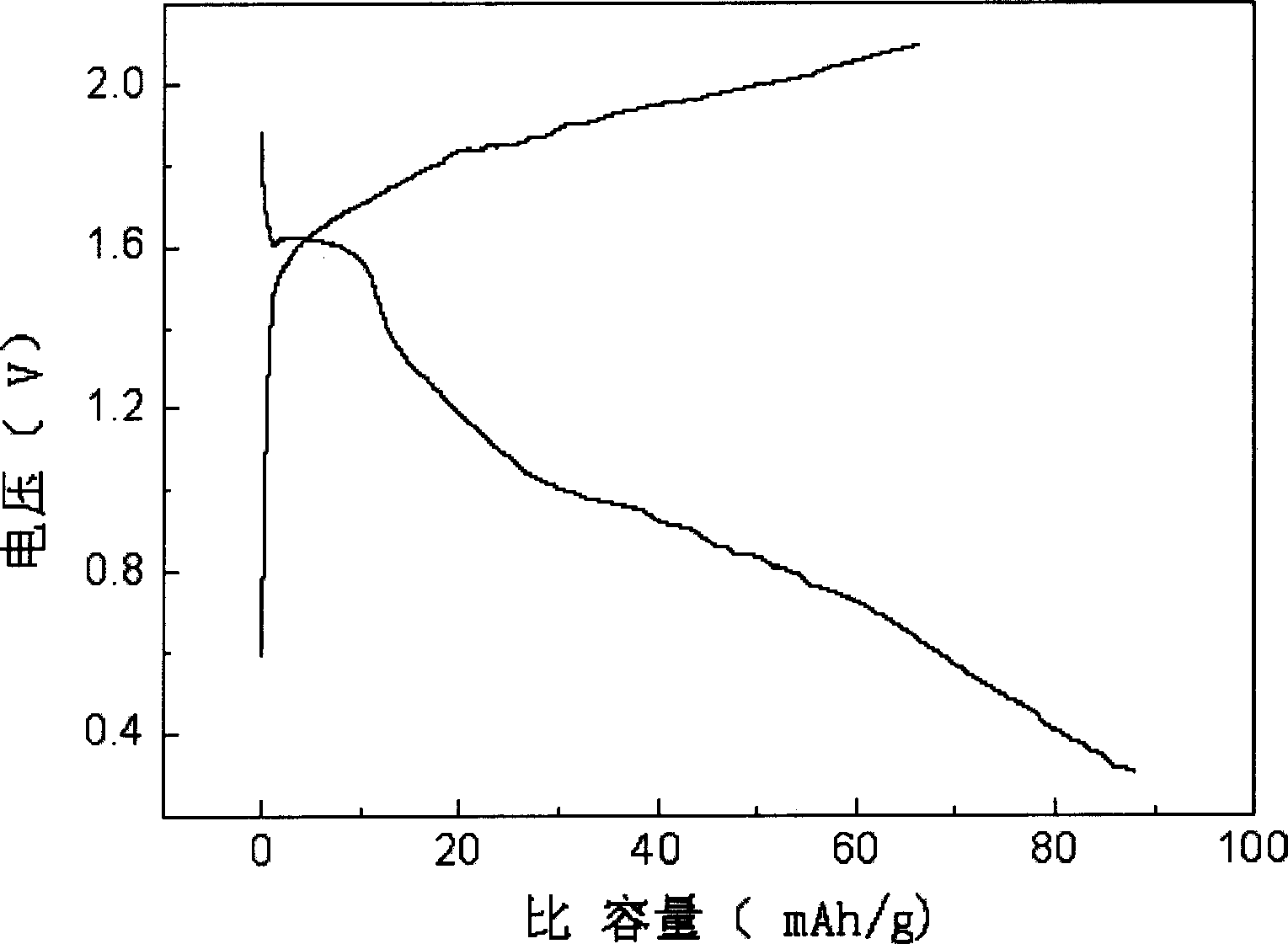Use of organic sulfur polymer in secondary magnesium cell anode material
A technology for positive electrode materials and polymers, which is applied in the application field of organic sulfur polymers in secondary magnesium battery positive electrode materials, can solve problems such as preparation difficulties, and achieve the effects of increasing specific capacity, increasing conductivity, and increasing specific capacity
- Summary
- Abstract
- Description
- Claims
- Application Information
AI Technical Summary
Problems solved by technology
Method used
Image
Examples
Embodiment 1
[0020] Add 1.63 mg of acetylene black and 1.63 mg of polytetrafluoroethylene to the finely ground 20 mg of partially dithiopolyaniline (see literature for the synthesis process of the material: Tang Zhiyuan, Xu Guoxiang, Polymer Materials Science and Engineering, 2003, 19: 175). Emulsion (concentration: 60wt%), mixed into a paste, pressed on the copper foil under 4MPa pressure, placed in an oven with a temperature of 80°C for drying, punched into pole pieces with a punch of Φ12.5mm, and punched into pole pieces at a pressure of 1MPa After tableting under pressure, put it in a vacuum oven at about 100°C and dry it for 4 hours to obtain 1.5 mg of positive electrode; then transfer it to an argon glove box, use metal magnesium as negative electrode, 0.25mol L -1 Mg[AlCl 2 (C 4 h 9 )(C 2 h 5 )] 2 / Tetrahydrofuran is used as the electrolyte to make a button-type secondary magnesium battery. The test charge and discharge current density is 25mA·g -1 , The charge and discharge...
Embodiment 2
[0022]Add 1.63 mg of acetylene black and 1.63 mg of polytetrafluoroethylene emulsion to 20 mg of finely ground tetrathiodianiline (see literature for the synthesis process of materials: Tang Zhiyuan, Xu Guoxiang, Yu Bitao, Liu Chunyan, Science and Technology Progress, 2001, 8:28). (Concentration: 60wt%), mix it into a paste, press it on the copper foil under the pressure of 4MPa, put it in an oven with a temperature of 80°C, and punch it into a pole piece with a punch of Φ12.5mm. After pressing down, place it in a vacuum oven at about 100°C for 4 hours to dry to obtain a 1.5 mg positive electrode; then transfer it to an argon glove box, use metal magnesium as the negative electrode, 0.25mol L -1 Mg[AlCl 2 (C 4 h 9 )(C 2 h 5 )] 2 / Tetrahydrofuran is used as the electrolyte to make a button-type secondary magnesium battery. The test charge and discharge current density is 25mA·g -1 , The charge and discharge voltage range is 0.3V ~ 2.0V. The first discharge capacity is ...
Embodiment 3
[0024] Add 1.63mg of acetylene black and 1.63mg polytetrafluoroethylene emulsion (concentration: 60wt%), mix it into a paste, press it on the copper foil under the pressure of 4MPa, put it in an oven with a temperature of 80°C and dry it, and punch it with a punch of Φ12.5mm After the pole piece is pressed under a pressure of 1MPa, put it in a vacuum oven at about 100°C and dry for 4 hours to obtain a 1.5mg positive electrode; then transfer it to an argon glove box, use metal magnesium as the negative electrode, and 0.25mol L -1 Mg[AlCl 2 (C 4 h 9 )(C 2 h 5 )] 2 / Tetrahydrofuran is used as the electrolyte to make a button-type secondary magnesium battery. The test charge and discharge current density is 25mA·g -1 , The charge and discharge voltage range is 0.3V ~ 2.0V. Two discharge plateaus appeared at around 1.5V and 1.0V, and the discharge capacity increased with the increase of the sulfur mass fraction in the synthesis product. When the sulfur mass fraction was 78...
PUM
 Login to View More
Login to View More Abstract
Description
Claims
Application Information
 Login to View More
Login to View More - R&D
- Intellectual Property
- Life Sciences
- Materials
- Tech Scout
- Unparalleled Data Quality
- Higher Quality Content
- 60% Fewer Hallucinations
Browse by: Latest US Patents, China's latest patents, Technical Efficacy Thesaurus, Application Domain, Technology Topic, Popular Technical Reports.
© 2025 PatSnap. All rights reserved.Legal|Privacy policy|Modern Slavery Act Transparency Statement|Sitemap|About US| Contact US: help@patsnap.com


